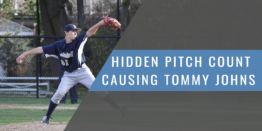| Improve Fundamentals With These Baseball
Catcher Drills |
| By: Brian Smith
Provided by: STACK
These baseball catcher drills progress from beginner to intermediate to advanced. They should be performed in order while wearing your equipment. When they come to train with us, we take each catcher regardless of age through each level. The fundamentals of receiving, blocking, and throwing are the same for all levels. These drills should be included in each catcher's workout or practice plan. A good catcher can make a bad pitcher look good, and a bad catcher can make a good pitcher look bad. |
Beginner Baseball Catcher Drills |
Receiving Drills:Tennis Ball Barehanded: Coach tosses a tennis ball to the catcher without a glove on. Catcher should work on having soft hands and just catch the ball. Receiving Baseballs from a Short Distance: Coach tosses baseballs to the catcher with a glove on from 10-12 feet away. Blocking Drills: 3-Ball Drill: Place three baseballs in front of the catcher and demonstrate how to move in order to block each baseball successfully. Coaching cue: Catcher should land on knees, glove between knees, bare hand behind mitt, and chin tucked into chest. Tennis Balls: Coach bounces the ball in front of the catcher to demonstrate how to be aggressive when blocking. Beginner catchers have a tendency to turn away from the ball. The key to this drill is for the catcher to watch the ball all the way in to the chest. Keeping the head in line with and focused on the ball allows the face mask to cover the neck of the catcher. If the catcher turns his head, the risk of getting hit in the throat increases. Use the chest protector to keep the ball in front. The glove should drop down between the knees, with the catcher's throwing hand behind the mitt. This creates a "wall" for the ball to stay in front of the catcher. Beginners become confident with tennis balls, then move to baseballs for this drill. Throwing Drill: Footwork to Second Base: Beginner catchers should learn proper footwork toward the base where they are throwing the baseball. We use a T (in tape on the ground) to work on footwork to second base. The catcher's feet should land on the bottom line of the T with his throwing foot landing first, then the glove foot. Coaching cue: Let the catcher work through this drill finding balance/athletic stance from which to throw. |
Intermediate Baseball Catcher Drills |
Receiving Drills:Tennis Ball Barehanded: Coach throws a tennis ball to the catcher without a glove on. Catcher should work on receiving the ball between his thumb and index finger. Receiving Baseballs From a Short Distance: Coach throws baseballs to the catcher with a glove on from 14-16 feet away. Receiving Baseballs From a Pitching Machine: Coach sets the machine at a speed comparable to game speed. Blocking Drills: Tennis Balls: Coach bounces the ball in front of the catcher to teach him to catch the baseball. Intermediate catchers are challenged to "absorb" the tennis ball, trying to make their body soft when the ball makes contact with their body. We tape a semicircle 5 feet in front of the catcher and challenge him to keep the ball inside that perimeter. This allows him to get to the baseball quicker when a runner attempts to steal a base on a ball thrown in the dirt. Gain Ground: Catcher gets into receiving stance. Coach points right, left, or straight down, directing the catcher to get into a blocking position and immediately bounce back up into a receiving stance. Throwing Drill: Footwork to Bases: Intermediate catchers work on throwing to each base, starting with the ball in his mitt. Coach walks around the catcher and offers cues. Coaching cues are to make sure the catcher maintains balance throughout his footwork to each base while working on transferring the ball from the mitt to the bare hand. |
Advanced Baseball Catcher Drills |
Receiving Drills:Baseball Barehanded: Coach tosses a baseball to the catcher without a glove on. Catcher should receive the ball between his thumb and index finger. Receiving Baseballs From a Pitching Machine: Coach sets the machine at a speed faster than game speed. 3-Man Quick Hands: Coach plus two other players have five baseballs and stand in a semicircle in front of the catcher, approximately 12 feet away. The player on one side throws a ball to the catcher, then the middle guy, then the guy on the other side throws a ball. The speed of this drill can become extremely quick with more advanced catchers. Coaching cue: Catcher should receive each pitch, drop the ball and immediately focus on the next ball. Blocking Drills: Blocking Without a Mitt: Catcher places his hands behind his back. This trains him to use his chest protector to block the ball. Coaching cue: Bounce the ball far enough in front of the catcher so it takes a long hop. Short hops can result in the baseball hitting the catcher in a painful area. Block It and Get up: This teaches the catcher how to block the ball and bounce up quickly to get to the baseball. Coaching cue: 10 repetitions, then let the catcher rest while another catcher performs the drill. Throwing Drills: Footwork to Bases: Advanced catchers need to focus on reducing the time it takes to catch and release the baseball. The "touch to release" goal for our catchers is under eight tenths of a second. Throwing From Knees: Yes, we work with our catchers on throwing to all three bases from their knees. There will be times in a game when the pitch is low or in the dirt, and throwing from their knees may be the only option. This drill also focuses on the transfer of the ball from mitt to throwing hand. |






